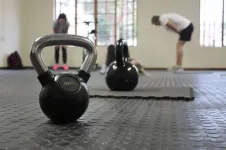(Press-News.org) Rapid side-to-side eye movements can help stabilize posture, avoid falls and maintain balance for people with Parkinson’s disease, just as they can for healthy people. This seemingly counterintuitive conclusion was reached by researchers at São Paulo State University (UNESP) in Brazil and the University of Lille in France in a study supported by FAPESP. An article on the study is published in the journal Biomechanics.
Ten individuals diagnosed with Parkinson’s and 11 neurologically healthy individuals participated in the study. All participants were over 60 and were submitted to tests that involved standing still and trying to maintain balance with their feet side by side and parallel, or one foot in front of the other (tandem stance), while making horizontal or vertical saccadic eye movements, or gazing steadily at a fixed target.
Horizontal saccadic eye movements rather than gaze fixation correlated with significantly reduced body sway for both the healthy participants and those with Parkinson’s, regardless of the position of the feet (side-by-side or tandem), while vertical saccadic eye movements correlated with increased body sway for the latter group.
“It’s not an automatic strategy to avoid losing balance and falling, since routinely moving the eyes rapidly from side to side is difficult. You can train horizontal saccadic eye movement, but this study was aimed at basic research rather than practical recommendations. We didn’t expect people with Parkinson’s to be capable of combining these two movements. Our findings furnish new knowledge of the disease, and of its motor and cognitive consequences,” said Fabio Barbieri, first author of the article. He heads UNESP’s Human Movement Research Laboratory (MOVI-LAB) and runs an outreach project called “Active Parkinson” offering patients physical activities twice a week free of charge on its Bauru campus.
Unexpected benefit
When the researchers began the study, they thought eye movements could not help Parkinson’s patients maintain stability and avoid falls. “Individuals with this disease have a postural deficit that impairs stability and sway control. They also have difficulty controlling their eye movements. Their blinking tends to be slow, and it’s hard for them to pick information from the environment,” Barbieri said.
Postural improvement correlated with horizontal saccadic eye movements, while body stability worsened in conjunction with vertical saccadic eye movements. “For young adults, vertical saccadic eye movements are beneficial, but for older adults they don’t reduce body sway. Although Parkinson’s patients can make vertical saccadic eye movements, they can’t adapt [by reducing sway] as well as they can to horizontal saccadic eye movements because up-and-down movements are more difficult in general and involve a lower degree of eye rotation, hindering integration between the sensory system [i.e. the eyes] and the postural system [i.e. the body],” said Sérgio Tosi Rodrigues, last author of the article and head of the Laboratory of Information, Vision and Action (LIVIA) at UNESP’s Department of Physical Education in Bauru, where he is a full professor.
Tosi Rodrigues has conducted studies on postural stability and saccadic eye movements in different populations, such as healthy young and older adults, diabetics, and multiple sclerosis as well as Parkinson’s patients.
The results of previous studies suggest the postural control system receives both visual information from images projected on the retina and inputs from the muscles that move the eyes, which help reduce body sway.
“Besides limitations due to a disease, such as Parkinson’s, control of gaze and posture seems to vary with age. Generally speaking, the natural aging process leads to a deterioration of motor control and visual perception, among other alterations. Visual functions perform less well in older than younger people, for example, potentially making older people more susceptible to falls,” Tosi Rodrigues said.
According to Barbieri, “combining static balance with vertical saccadic eye movements may be difficult for Parkinson’s patients, increasing body sway as a result”.
In healthy individuals, vertical and horizontal saccadic eye movements benefited postural stabilization more than fixed gaze. “This happens because postural control is backgrounded. To try to simplify what’s complex, there’s a change in attention. The subject shifts attention from posture to focus on eye movement, requiring more caution from the brain in order to control posture and stability so as to avoid a fall,” Barbieri said.
About São Paulo Research Foundation (FAPESP)
The São Paulo Research Foundation (FAPESP) is a public institution with the mission of supporting scientific research in all fields of knowledge by awarding scholarships, fellowships and grants to investigators linked with higher education and research institutions in the State of São Paulo, Brazil. FAPESP is aware that the very best research can only be done by working with the best researchers internationally. Therefore, it has established partnerships with funding agencies, higher education, private companies, and research organizations in other countries known for the quality of their research and has been encouraging scientists funded by its grants to further develop their international collaboration. You can learn more about FAPESP at www.fapesp.br/en and visit FAPESP news agency at www.agencia.fapesp.br/en to keep updated with the latest scientific breakthroughs FAPESP helps achieve through its many programs, awards and research centers. You may also subscribe to FAPESP news agency at http://agencia.fapesp.br/subscribe.
END
Rapid horizontal eye movement can improve stability in people with Parkinson’s
Vertical eye movements increased body sway in an experiment involving volunteers with the disease conducted by researchers at São Paulo State University (Brazil) and the University of Lille (France).
2024-10-30
ELSE PRESS RELEASES FROM THIS DATE:
Study finds COVID-19 pandemic worsened patient safety measures
2024-10-30
PHILADELPHIA (October 30, 2024) – A new study – published in Nursing Research – has found that the COVID-19 pandemic significantly impacted patient safety indicators in U.S. hospitals. The study, from Penn Nursing’s Center for Health Outcomes and Policy Research (CHOPR), examined data from the National Database of Nursing Quality Indicators to assess trends in nursing-sensitive quality indicators from 2019 to 2022. The prevention of these very distressing, uncomfortable conditions is considered to be under the nurse’s purview and directly influenced by nursing care.
The investigation found that rates of falls, bloodstream infections from ...
Costs still on the rise for drugs for neurological diseases
2024-10-30
MINNEAPOLIS – The amount of money people pay out-of-pocket for branded drugs to treat neurological diseases like multiple sclerosis (MS), Alzheimer’s, and Parkinson’s disease continues to rise, especially for MS drugs, according to a study published in the October 30, 2024, online issue of Neurology®, the medical journal of the American Academy of Neurology. The study found that average out-of-pocket costs for drugs for MS increased by 217% over a nine-year period.
Costs have dropped for medications where generic versions have been introduced.
“In some ...
Large herbivores have lived in Yellowstone National Park for more than 2,000 years
2024-10-30
Large herbivores like bison or elk have continuously lived in the Yellowstone National Park region for about 2,300 years according to a new analysis of chemicals preserved in lake sediments. John Wendt of Oklahoma State University, U.S., and colleagues present these findings in the open-access journal PLOS ONE on October 30, 2024.
The near-extinction of bison in North America in the 19th and 20th centuries was a major ecological catastrophe and little is known about where and how these animals lived before European colonization. In the new study, researchers attempted to determine the dominant large herbivores that lived in the northern Yellowstone National Park ...
Antarctic penguin colonies can be identified and tracked from tourists' photos, using a computer model to reconstruct the 3D scene
2024-10-30
Antarctic penguin colonies can be identified and tracked from tourists' photos, using a computer model to reconstruct the 3D scene
###
Article URL: https://journals.plos.org/plosone/article?id=10.1371/journal.pone.0311038
Article Title: Penguin colony georegistration using camera pose estimation and phototourism
Author Countries: U.S.A.
Funding: This work was supported in part by the NASA Biodiversity Program (Award 317 80NSSC21K1027), and NSF Grant IIS-2212046. The funders had no say in the study design, data collection and analysis, decision to publish, or preparation of the manuscript. END ...
For patients with alcohol use disorder, exercise not only reduces alcohol dependence, but also improves mental and physical health, per systematic review
2024-10-30
For patients with alcohol use disorder, exercise not only reduces alcohol dependence, but also improves mental and physical health, per systematic review
###
Article URL: https://journals.plos.org/plosone/article?id=10.1371/journal.pone.0311166
Article Title: Effectiveness of exercise intervention in improving physical and mental status of patients with alcohol use disorders: A systematic review and meta-analysis
Author Countries: China
Funding: This study was funded by a grant from the National ...
Bones from Tudor Mary Rose shipwreck suggest handedness might affect collarbone chemistry
2024-10-30
Editor's Note: Please do not include the image originally uploaded with this release in any of your coverage as the licensing information has now changed. Please contact onepress@plos.org for any questions. Updated: October 30, 2024
A new study of human skeletal remains from the wreck of the 16th century English warship Mary Rose suggests that whether a person is right- versus left-handed may influence how their clavicle bone chemistry changes as they age. Dr. Sheona Shankland of Lancaster University, U.K., and colleagues present these findings in the open-access journal PLOS ONE on October 30, 2024.
The ...
Farewell frost! New surface prevents frost without heat
2024-10-30
Someday, people might finally say goodbye to defrosting the freezer or scraping frost off slippery surfaces. Northwestern University engineers have developed a new strategy that prevents frost formation before it begins.
In a new study, the researchers discovered that tweaking the texture of any surface and adding a thin layer of graphene oxide prevents 100% of frost from forming on surfaces for one week or potentially even longer. This is 1,000 times longer than current, state-of-the-art anti-frosting surfaces.
As an added bonus, ...
Similarities in brain development between marmosets and humans
2024-10-30
The development of primate brains is shaped by various inputs. However, these inputs differ between independent breeders, such as great apes, and cooperative breeders, such as the common marmoset (Callithrix jacchus) and humans. In these species, group members other than the parents contribute substantially to raising the infants from birth onwards.
A group of international researchers led by Paola Cerrito from the University of Zurich’s Department of Evolutionary Anthropology studied how such social interactions map onto brain development in common marmosets. The study provides new insights into the relationship between the timing of brain development ...
Can we protect nerve cells from dying?
2024-10-30
LEUVEN October 31st - Alzheimer’s disease is characterized by a progressive loss of nerve cells leading to a decline in memory and cognition. A team of researchers at KU Leuven and VIB explored the molecular sequence of events in this cellular demise and identified specific inhibitors that could prevent the loss of nerve cells in different mouse models of the disease. The findings open up new research avenues in the search for therapies that could halt or prevent the accumulation of brain damage occurring in ...
Why does Lake Geneva emit large quantities of CO2? UNIL scientists provide the answer and solve a scientific enigma
2024-10-30
Unlike oceans, lakes are significant emitters of CO₂. But why is this the case, and what mechanisms are at play? For the first time, UNIL scientists have successfully explained the complete carbon cycle in Lake Geneva, creating a model that can be applied to several of the world's largest lakes.
Contrary to previous beliefs, it is the natural erosion of rocks that is responsible for the significant CO2 emissions from Lake Geneva and many of the world's large lakes.
This study provides the missing piece for understanding the carbon cycle in lakes.
The LéXPLORE lake platform in Switzerland played a major role in this discovery of international ...
LAST 30 PRESS RELEASES:
UVA’s Jundong Li wins ICDM’S 2025 Tao Li Award for data mining, machine learning
UVA’s low-power, high-performance computer power player Mircea Stan earns National Academy of Inventors fellowship
Not playing by the rules: USU researcher explores filamentous algae dynamics in rivers
Do our body clocks influence our risk of dementia?
Anthropologists offer new evidence of bipedalism in long-debated fossil discovery
Safer receipt paper from wood
Dosage-sensitive genes suggest no whole-genome duplications in ancestral angiosperm
First ancient human herpesvirus genomes document their deep history with humans
Why Some Bacteria Survive Antibiotics and How to Stop Them - New study reveals that bacteria can survive antibiotic treatment through two fundamentally different “shutdown modes”
UCLA study links scar healing to dangerous placenta condition
CHANGE-seq-BE finds off-target changes in the genome from base editors
The Journal of Nuclear Medicine Ahead-of-Print Tip Sheet: January 2, 2026
Delayed or absent first dose of measles, mumps, and rubella vaccination
Trends in US preterm birth rates by household income and race and ethnicity
Study identifies potential biomarker linked to progression and brain inflammation in multiple sclerosis
Many mothers in Norway do not show up for postnatal check-ups
Researchers want to find out why quick clay is so unstable
Superradiant spins show teamwork at the quantum scale
Cleveland Clinic Research links tumor bacteria to immunotherapy resistance in head and neck cancer
First Editorial of 2026: Resisting AI slop
Joint ground- and space-based observations reveal Saturn-mass rogue planet
Inheritable genetic variant offers protection against blood cancer risk and progression
Pigs settled Pacific islands alongside early human voyagers
A Coral reef’s daily pulse reshapes microbes in surrounding waters
EAST Tokamak experiments exceed plasma density limit, offering new approach to fusion ignition
Groundbreaking discovery reveals Africa’s oldest cremation pyre and complex ritual practices
First breathing ‘lung-on-chip’ developed using genetically identical cells
How people moved pigs across the Pacific
Interaction of climate change and human activity and its impact on plant diversity in Qinghai-Tibet plateau
From addressing uncertainty to national strategy: an interpretation of Professor Lim Siong Guan’s views
[Press-News.org] Rapid horizontal eye movement can improve stability in people with Parkinson’sVertical eye movements increased body sway in an experiment involving volunteers with the disease conducted by researchers at São Paulo State University (Brazil) and the University of Lille (France).






